Teach Your Pup to Sit and Stay
By Michele Welton, Dog Trainer, Breed Selection Consultant, Author of 15 Dog Books
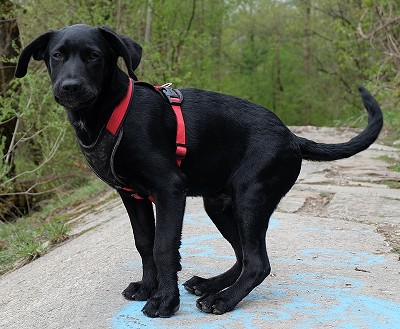
Charlie has learned how to sit exactly as his owner taught him: ignore the commands, crouch until the treat appears, then sit all the way down.
Some owners say, "I've already taught my pup to sit." But when I ask for a demonstration, this is usually how it goes....
"Sit, Charlie. Sit down. Come on, Charlie, sit. Sit! Charlie?"
As that voice gets louder, Charlie's hindquarters begin to go down and the owner's face lights up with a hopeful expression. But Charlie, knowing how to milk this for all it's worth, just remains in that nowhere land between standing and sitting. At this point the frustrated owner usually gives up and holds up a treat. Then Charlie sits.
Remember that dogs learn from patterns and consequences. Charlie's owner had taught her pup that it's perfectly fine to futz around while she spews out a bunch of sounds. In the end, he always gets the treat anyway, so why do more than the minimum?
Ughh! Let's instead teach your pup that he will hear one Sit sound, then he will sit, either on his own or with your "help".
And then – very important, this – he must remain sitting until given permission to get up.
Why is that important? Because Sit is a controlled position, which might be why you told him to sit in the first place. For example, let's say you want Charlie to sit so the vet can examine his eyes. The vet waits and waits, surreptitiously checking his watch as Charlie keeps touching his bottom to the floor then immediately bouncing up again.
Not surprisingly, the vet doesn't find this very helpful.
What you want Sit to mean is "Plunk your bottom on the floor and keep it there until I tell you otherwise."
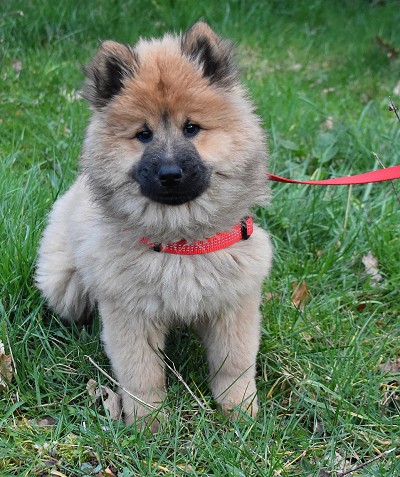
This is a young Eurasier, a type of 'spitz', which is a group of cold-climate dog breeds with prick ears, thick coat, and curled tail.
Sit is a marvelous control word that puts your pup in an accessible position for examining, grooming, or attaching the leash.
Sit also gives your pup a way to say "Please." For example, I have my dogs give me a polite sit before I put their food bowls on the floor or attach their leashes for a walk.
So even if you think your dog already knows how to Sit, it's worthwhile to teach him to sit on one command and to remain sitting until you release him with "Okay." This is very do-able!
First, teach Sit by luring with food
Don't worry, we're going to phase out the food. But if your pup is motivated by food, it's a good way to start.
- With your pup on leash and standing more or less in front of you, say, "Sit." Say it only once. Pronounce that "t" at the end: siT. Your voice shouldn't go UP at the end. Don't ask "Sit??"
- Move a tasty treat toward his nose. But before it gets there, lift it a little higher as you keep it moving slowly up and over his muzzle, up and over his eyes, and up between his ears.
To keep his eyes on the treat as it moves up over his head, your pup needs to bend his neck back. But because his neck can't bend back very much when he's standing, many dogs will drop their hindquarters into a sitting position so they can see better.
It takes some practice to get the trajectory of the moving treat just right. Don't hold it too high, else he'll jump for it!
- If he didn't drop into a sit on his own, pull slightly upward and backward with the leash, just a little bit. Often that will be enough to nudge him into a sit. If not, use your other hand to push down on his hindquarters (just behind his two hipbones, near his tail). Don't push down on his back.
Whatever it took to get him sitting, say "Yes!" or "Good!" and then give him the treat. It's okay if he doesn't remain sitting yet. We'll work on that soon.
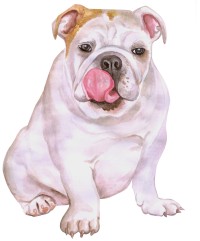 Phase out the food
Phase out the food
After many repetitions where you lure the pup into a Sit with food and/or the leash and/or your hands.... it's time to phase out the food lure. Don't show him any food at all – keep it hidden in your pocket.
Say "Sit" and add the familiar hand motion just over his head (but with no food). If he sits, say "Yes" or "Good" and then reach into your pocket and pull out the treat.
So follow this pattern: say Sit → he sits → praise → reach for the treat
Now you can phase out the treats by progressing from constant treating (every time) to variable treating (every other time, or every 3rd time) to random treating (only occasionally).
Remember, if your pup doesn't sit on one command, don't repeat it. Just place him into a Sit with a leash tug or your hands.
If he's persistent about not sitting on his own, make your leash tug more firm. You want him to conclude that sitting on his own is much more comfortable than being "helped."
Teach your dog to STAY sitting (basic)
Once your pup is reliably sitting on one command, start requiring him to HOLD the sit.
Get him sitting beside you so you're both facing the same direction. Shorten the leash by folding most of it into your hand so there's only a short length of leash between his collar and your hand.
Yes, usually when your dog is on-leash you want a very loose leash with a big loop in it. But for this exercise, a short leash is better.
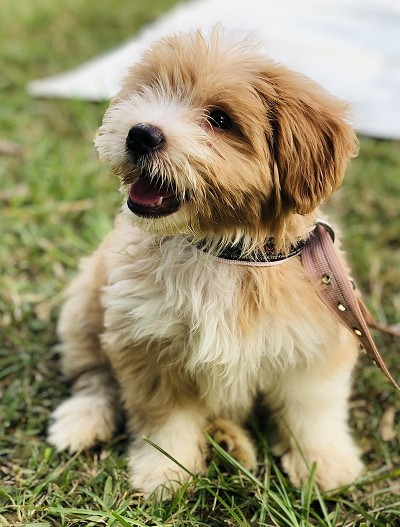
Just sittin' there, doin' nowt.
Then... just stand there, while your dog just sits there.
If he tries to stand up or lie down, check him with the leash. That means quickly moving the leash in whichever direction will prevent him from standing or lying down. You might need to move it backward, or upward, or to the left or right. It's easier to check him when the leash is pretty short.
If you weren't quite fast enough and he gets all the way up, use the leash (and your hands if necessary) to reposition him in the sitting position. Don't repeat the word, no matter how many times you need to reposition him.
Be persistent. If he breaks his Sit 30 times, reposition him 30 times.
At first, aim to have him stay sitting for just 5 seconds. Then say, "Okay" and encourage him to get up and move around. Gradually increase to 15 and then 30 seconds. Yup, it's kind of a boring exercise when you're both doing nothing, but that's about to change!
Teach your dog to STAY sitting (intermediate)
So far you've been teaching your pup that "Sit" means sitting and staying there until you say "Okay."
So it isn't absolutely necessary to add the word "Stay."
But it's such an obvious word to use when we want a dog to stay put, isn't it? In my experience as both an owner and a trainer, we end up saying it anyway, so I just go ahead and teach it!
Now, I don't usually say it when I'm standing right beside my dog. But when I start moving away from my dog, especially outdoors or in a distracting environment, I do add "Stay" as a reminder.
So here's how to teach it:
- Get your pup sitting beside you, facing the same direction you are. Shorten the leash so you can quickly check him if he tries to move.
- Place your hand (either hand) in front of his face, no more than 12 inches from his eyes, your palm open and facing him, like a cautionary stop signal. If you remember, you introduced this hand signal when you were teaching him to Wait at open doors.
- At the same time as the hand signal, say, "Stay." Say it firmly, with confidence – telling, not asking.
- Now take a very short step in front of him and immediately pivot so you're facing him. There should be no more than 12 inches between your feet and his feet. As you pivot, raise the shortened leash over his head so it's slightly taut. Remember how you did this when you were reminding him to stay on his bed?
If he starts to stand up, say "AH-ah." Don't say "Stay." Dogs connect the sound they hear with the action they're performing at that moment. You don't want him to connect the sound Stay with the act (or even the thought) of moving!
As you say "AH-ah", be quick with the leash, tightening it upward and backward (toward his hindquarters) in an attempt to check him before he gets all the way up. If you're too slow, just reposition him without another word. Without moving your feet, you should be able to hold his front end in position with the leash, while you reach over and push his hind end into a sit, so he's back in the same place he started.
If instead he tries to lie down, again try to check him with the leash before he sinks all the way down. If you're too slow, use the leash or your hands to get him back up and reposition him without a word.
- On the first day you try this, aim for your pup to hold his Sit-Stay for 10 straight seconds. Count in your head. Each time you have to correct him, start your count again.
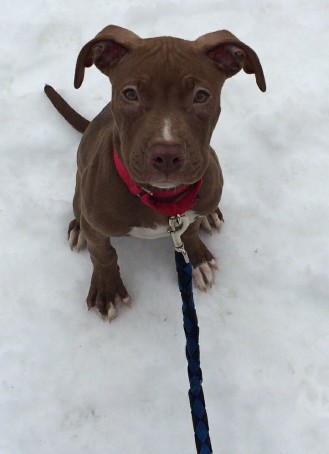
"Good puppy..."
- When he has held his position for 10 seconds, pivot back to your starting position at his side. Again, as you move, use the slightly taut leash over his head to help him hold his position.
- When you get back to his side, pause for 5 more seconds so he learns not to misinterpret your return as a cue to get up. If he does get up, just reposition him. Count to 5 again, then praise him calmly, "Gooood. Goood." If he gets up when you praise, just reposition him.
- Finally, when he is holding position for your praise, you can release him with a cheerful "Okay!"
- Each day, add another 5 to 10 seconds to your count so that by the end of the week he is holding his Sit for about a minute while you stand right in front of him.
- Also relax the leash so you aren't holding it over his head as a reminder to hold position. That's his responsibility now.
Don't rush your pup! Don't push him to hold a Sit-Stay for a full minute on the very first day and conclude that he is a Wonder Dog who doesn't need any more practice.
REPETITION/PRACTICE is what makes a dog rock-solid on the Sit-Stay. Like the concert pianist who faithfully practices simple finger exercises even when he could do them in his sleep, a pup who practices lots and lots of simple Sit-Stays will end up much better trained.
Teach your pup to STAY sitting (advanced)
Can your dog do these four things?
- Hold a Sit-Stay for a full minute?
- Hold a Sit-Stay even after you've returned to his side?
- Hold a Sit-Stay even while you're praising him?
- Hold a Sit-Stay until you release him with "Okay"?
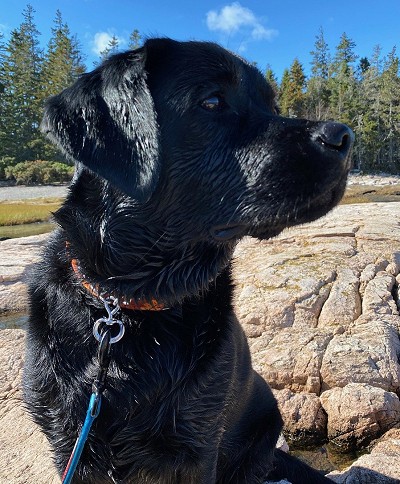
Black Labrador Retriever holding his sit-stay despite distractions
Yes? Then let's make it more interesting for both of you!
Circle around him
Instead of pivoting directly back to his side, walk in a very small circle around him, close beside him, before stopping at his side. At first, hold the leash slightly taut above his head as you go around him, to remind him to stay put. (It's perfectly fine if he wants to turn his head to see where you're going!)
Add distractions
Does your pup reliably hold his sit-stay for a full minute, even when you make a small circle when returning to his side? Great! Now add distractions to make his understanding even more solid:
- Hum or sing or whistle.
- Do a few knee bends or jumping jacks.
- Have one of your kids trot by, bouncing a ball.
Don't TEASE the dog! Don't pat your thighs to encourage him to come to you. Don't speak to him or stare at him.
You're not trying to make him fail. You're trying to build up his confidence that he CAN succeed.
Increase distance
Once your pup is successful with distractions while you're standing right in front of him, move to the end of the leash and repeat the distractions.
If he breaks his Sit-Stay now, when you're at the end of the leash, be sure to return to him to correct him.
Don't try to correct him from the end of the leash. You'll only end up pulling him TOWARD you.
Especially don't call out, "Stay!" when you see him starting to move. He should never hear that word when he's in the process of moving.
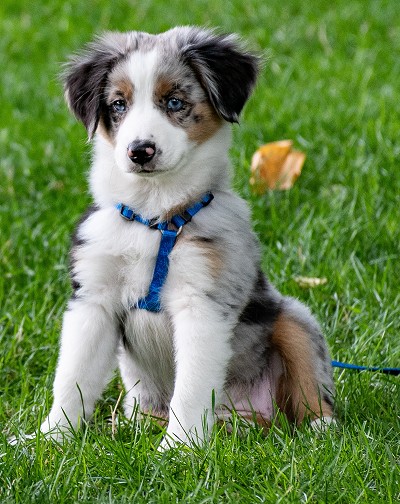
Blue merle Australian Shepherd puppy practicing a sit-stay.
Remember not to stare at him. If you meet his eyes, he may think you're inviting him to come to you. Or he may feel uncomfortable under your scrutiny and try to avoid your gaze by lying down or walking away.
So look to the right of your pup. Look to the left. Look up and count the dust bunnies on the ceiling or the clouds in the sky. Rely on your peripheral vision to keep track of your pup.
Increase time
Go from a minute to two minutes. That's plenty long enough for sitting still. If you need a pup to stay put for a longer period of time, have him go to his bed instead. There he can change his positions as he chooses.
Finally, drop the leash and walk around the room
And repeat your distractions.
"What's the difference between Wait and Stay?"
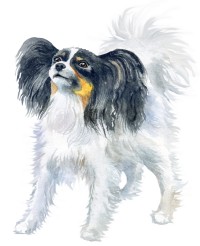 WAIT means "Don't cross a specific boundary." You use Wait when you don't want your pup to go through a door or gate, or enter a room, or jump out of your car.... until you say so.
WAIT means "Don't cross a specific boundary." You use Wait when you don't want your pup to go through a door or gate, or enter a room, or jump out of your car.... until you say so.
The boundary must be clear to your dog. In other words, he must be able to SEE the difference between "here" and "there." For example, a physical marker such as a door frame, or gate posts. Or an obvious change of footing such as vinyl floor to carpet, or grass to concrete.
With Wait, as long as your puppy doesn't cross the boundary, you don't care whether he stands, sits, lies down, or wanders around on his side of the boundary. He simply can't cross it.
 STAY means "Hold an exact position." If you told him to sit, he has to stay sitting. If you told him to lie down he has to stay lying down.
STAY means "Hold an exact position." If you told him to sit, he has to stay sitting. If you told him to lie down he has to stay lying down.
As you can see, Stay is much stricter than Wait. Sometimes you need that strictness. You might want your pup to sit still so the vet can examine his teeth. In such cases, it wouldn't do for your pup to flop onto his side. When you need your puppy to stay in a particular position, that's when you use Stay.
My best-selling books – now available FREE on my website
 Respect Training For Puppies: 30 seconds to a calm, polite, well-behaved puppy is for puppies 2 to 18 months old. Your puppy will learn the 21 skills that all family dogs need to know. Click here to read for free.
Respect Training For Puppies: 30 seconds to a calm, polite, well-behaved puppy is for puppies 2 to 18 months old. Your puppy will learn the 21 skills that all family dogs need to know. Click here to read for free. Teach Your Dog 100 English Words is a unique Vocabulary and Respect Training Program that will teach your adult dog to listen to you and do what you say. Click here to read for free.
Teach Your Dog 100 English Words is a unique Vocabulary and Respect Training Program that will teach your adult dog to listen to you and do what you say. Click here to read for free. 11 Things You Must Do Right To Keep Your Dog Healthy and Happy helps your dog live a longer, healthier life. Get my honest advice about all 11 Things before you bring home your new puppy, because some mistakes with early health care cannot be undone. Click here to read for free.
11 Things You Must Do Right To Keep Your Dog Healthy and Happy helps your dog live a longer, healthier life. Get my honest advice about all 11 Things before you bring home your new puppy, because some mistakes with early health care cannot be undone. Click here to read for free.
